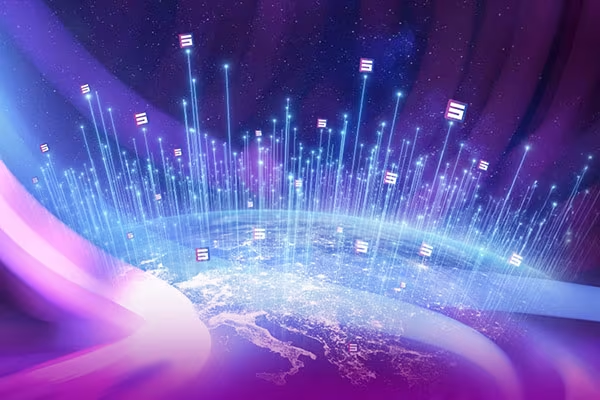

What is a Data Center? The digital world's nerve center
In today’s hyperconnected world, data is the lifeblood of modern civilization. From streaming movies and managing bank accounts to running global enterprises and smart cities, data flows continuously across digital networks. But where does all this data live? How is it processed, stored and protected? The answer lies in data centers - the physical and digital fortresses that power the internet, cloud computing, artificial intelligence and virtually every digital service we rely on. This blog dives deep into what data centers are, how they work and why they’re indispensable to the global economy.
1. Defining the Data Center
A data center is a facility that houses computing infrastructure - servers, storage systems, networking equipment, and power systems, designed to store, process and distribute data. It’s the central hub where digital operations are executed, monitored and secured. Think of it as the brain of the internet: a place where information is not only stored but actively managed, analyzed, and transmitted across the globe.
2. Core Components of a Data Center
To understand how data centers function, let’s break down their essential components:
🖥️ Servers
These are the workhorses of the data center. Servers run applications, host websites, manage databases, and perform computations. They come in various forms, rack-mounted, blade and tower servers - depending on the facility’s design and workload.
💾 Storage Systems
Data centers use high-capacity storage arrays to hold vast volumes of information. These systems include hard disk drives (HDDs), solid-state drives (SSDs) and network-attached storage (NAS).
🌐 Networking Equipment
Switches, routers, firewalls, and load balancers manage data traffic within the data center and between external networks. They ensure fast, secure, and reliable connectivity.
⚡ Power Infrastructure
Uninterruptible power supplies (UPS), backup generators, and power distribution units (PDUs) maintain continuous operation, even during outages.
❄️ Cooling Systems
Servers generate heat. Cooling systems ranging from air conditioning to advanced liquid cooling, regulate temperature to prevent overheating and hardware failure.
🔐 Security Systems
Physical security includes biometric access, surveillance cameras, and mantraps. Cybersecurity involves firewalls, encryption, intrusion detection, and compliance protocols.
3. Types of Data Centers
Data centers vary in size, ownership, and function. Here are the main categories:
🏢 Enterprise Data Centers
Owned and operated by a single organization, these facilities support internal IT operations. They’re often located on-premises and tailored to specific business needs.
🏬 Colocation Data Centers
Multiple organizations rent space in a shared facility. Colocation centers provide power, cooling, and connectivity, while clients manage their own hardware.
☁️ Hyperscale Data Centers
Massive facilities operated by tech giants like Amazon, Google, and Microsoft. They support cloud services and global-scale applications with thousands of servers.
🏙️ Edge Data Centers
Smaller, decentralized centers located closer to end-users. They reduce latency and support real-time applications like autonomous vehicles and smart cities.
4. Data Center Tiers and Standards
Data centers are classified by tiers, which indicate their reliability and redundancy:
- Tier I: Basic infrastructure, 99.671% uptime
- Tier II: Redundant components, 99.741% uptime
- Tier III: Concurrent maintainability, 99.982% uptime
- Tier IV: Fault tolerance, 99.995% uptime
Standards like ISO 27001, SOC 2 and PCI DSS ensure compliance with security and operational best practices.
5. What happens inside a Data Center?
📦 Data Storage
Files, databases, backups, and media are stored securely and redundantly.
🧠 Data Processing
Applications run computations, analytics, and AI models in real time.
🚦 Traffic Routing
Data is routed between users, applications, and external networks with minimal latency.
🔄 Backup and Recovery
Redundant systems and disaster recovery protocols ensure business continuity.
🛡️ Security Enforcement
Access controls, encryption and monitoring protect against cyber threats.
6. The role of Data Centers in modern society
Data centers are the invisible engines behind:
- Cloud Computing: Hosting services like AWS, Azure and Google Cloud
- E-Commerce: Powering platforms like Shopify and Amazon
- Finance: Supporting real-time trading and digital banking
- Healthcare: Storing patient records and running diagnostic algorithms
- Education: Enabling remote learning and digital classrooms
- Entertainment: Streaming video, music, and gaming content
7. Trends Shaping the Future of Data Centers
🌱 Sustainability
Data centers are adopting renewable energy, efficient cooling, and carbon offset strategies to reduce environmental impact.
🧠 AI and Automation
AI-driven monitoring, predictive maintenance, and robotic management are enhancing operational efficiency.
🧊 Advanced Cooling
Technologies like immersion cooling (see our dedicated blog) are revolutionizing thermal management.
🛡️ Cybersecurity
Zero-trust architectures, AI-based threat detection, and compliance automation are becoming standard.
🏗️ Modular Design
Prefabricated modules allow rapid deployment and scalability.
8. Challenges Facing Data Centers
Despite their importance, data centers face several challenges:
- Energy Consumption: Balancing performance with sustainability
- Heat Management: Cooling high-density workloads efficiently
- Security Threats: Combating increasingly sophisticated cyberattacks
- Regulatory Compliance: Navigating global data protection laws
- Scalability: Meeting exponential demand without compromising reliability
9. The Greek Data Center Landscape
Greece is emerging as a strategic location for data centers due to its geographic position, growing digital economy and investment in fiber infrastructure. Companies like Synapsecom are leading the charge with Tier III-certified facilities that support regional and international clients.
Why Choose Synapsecom?
Synapsecom is Greece’s premier data center provider, offering high-availability colocation, cloud hosting and disaster recovery services. Our facilities are designed for performance, security, and scalability, backed by ISO certifications and 24/7 expert support. Whether you're a startup or a multinational, Synapsecom delivers the infrastructure you need to thrive in a digital-first world.
Get in touch with us | Find out more about CoolBlock
Follow us on social media for company’s updates and industry news 👇




